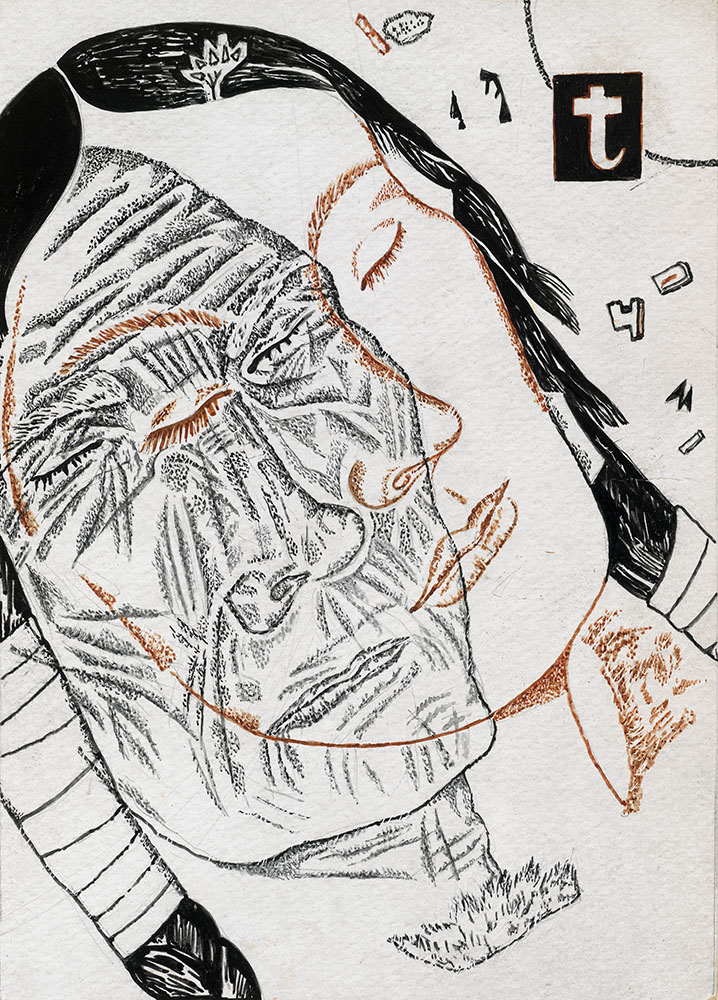MacDougall Auctions 2-3 December 2009
2 December 2009

376. FILONOV, PAVEL and PORET, ALISA 1883-1941 and 1902-1984
Two Faces
Pen and black and red ink on paper, 16.5 by 12 cm.
20,000-30,000 pounds
Provenance: The Lothar Bolz collection, Germany.
Acquired from the above by the present owner.
Private collection, the Netherlands.
The selection of drawings being presented at this auction is an important part of Russia’s artistic heritage that is located abroad. The collection was built up in Soviet Russia between the 1930s and the 1960s by a German, Lothar Bolz. He fled from Hitler’s regime and in 1933 moved to Moscow, where he became a lecturer in philosophy and law at the Institute of Marxism-Leninism. As he had for a long time been attracted to the fine arts (which he had studied in Munich in the 1920s) olz became acquainted with many well-known artists and journalists in Moscow, and later they were to become his close friends. Having sufficiently broad options and easily available resources, Bolz showed a preference in particular for collecting drawings, for in these he saw the specific individuality and stylistic variety of Russia’s richly-talented art. When he returned to the German Democratic Republic, Bolz became president of the Russian-German Friendship Federation, and soon after, minister for foreign affairs of the GDR. The current owner of the collection, a friend of Lothar Bolz’s family, obtained the most valuable items in the collection directly from Bolz himself between 1977 and 1986, and later on from his daughter. The main sheets of the collection have been exhibited in many famous Western museums and have frequently been reproduced in well-known exhibition catalogues and in specialised monographs on graphic art. The items in the collection include genuine masterpieces in watercolours and other media that reflect the artist’s true essence, attitude and individuality, and his or her place in the sphere of Russian graphic culture. Leading names include Kuzma Petrov-Vodkin, Lyubov Popova, Zinaida Serebriakova, Nathan Altman, Alexander Samokhvalov, Alisa Poret, Tatiana Mavrina and other remarkable artists who contributed to the prestige of the Russian artistic school. The value of the current material lies in its varied “applied” tendency. This includes original studies of models from life, plein air landscapes and the traditional book illustrations that are an integral part of easel art. The varying degree of completeness of the works reflects the artists’ stylistic preferences and also the way that they dealt with specific artistic tasks. The famous Kuzma Sergeyevich Petrov-Vodkin is represented by a magnificent watercolour study of a skull painted in 1913. It was at this time that the artist’s style had finally become established, and it defined his personal colouristic preferences and specific utilisation of planes to construct the images in his works. The hard tonal drawing and contiguity of the blotches of colour give this striking work a freshness of perception and exceptional originality. A rare study from life by Lyubov Popova, dated 1915, reflects the artist’s strivings towards expression and constructive generalisation.The minimalist variations on one colour are a device that Popova hardly ever used in her completed works executed in oils. Of great interest are two sheets by Alisa Poret, one of Pavel Filonov’s students and a leading representative of his school. A large number of talented individuals gathered round Filonov, and this led to the creation of one of Russia’s most interesting artistic associations, known to history as the Mastera Analitiches ko go Iskusstva (Masters of Analytical Art). Two Faces and The Bride were created in 1933 based on motifs from the legendary Finno-Karelian epic Kalevala. The Bride was included in a famous edition of the work, now a bibliographical rarity, published in two languages, Finnish and Russian, in 1933 by the Leningrad publishing-house ACADEMIA. There is no doubt that it was Poret herself who produced the actual picture, but the respect that the members of the association had for Filonov was so great that many of his students always associated their own thoughts and actions with the exhortations of their teacher; they defined their own creativity by its close contact with that of Filonov and considered their works to have been produced directly under the master’s guidance. Unlike his Leningrad colleagues Pakhomov and Lebedev, Alexander Samokhvalov turned to book illustrations far less often. However, the beautiful sheet from Saltykov-Schedrin’s The History of One Town shows the artist to be a magnificent master of the form. The characters of the people in the illustration to the story are clearly defined with great humour and taste. The virtuoso control over watercolour techniques lacks any narcissism and is totally subservient to the meaning of the text. Using the works of Gogol, Nathan Altman, another prominent 20th-century Russian artist, anticipated the development of the post-avant-garde mystical and romantic trend in book illustration that was seized upon and modified by Mikhail Chemiakin at the end of the 1960s. Without exception, each of the works from the collection of Lothar Bolz is valuable in its own right, and they represent a unique exposition reflecting as a whole the many trends and developments in XX century Russian and Soviet graphic art.
Notes on symbols:
* Indicates 5% Import Duty Charge applies.
Ω Indicates 20% Import Duty Charge applies.
§ Indicates Artist's Resale Right applies.
† Indicates Standard VAT scheme applies, and the rate of 20% VAT will be charged on both hammer price and premium.